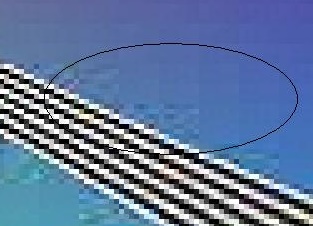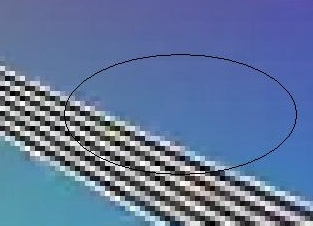Both formats store more information on a single disc than regular DVDs do, mainly by virtue of employing a new, blue-colored laser. Standard DVDs are played by a red laser beam with a longer wavelength than that of a blue laser. As a result, the tiny pits in the surface of a standard DVD which record information can get only so small. With a blue laser, they can get much smaller — so there can be more information put on the disc.
The Blu-ray laser has an even shorter wavelength than the HD DVD laser — the color is not actually blue, but blue-violet — so Blu-ray discs can encode more data in tinier pits than can HD DVD.
You need more information to carry hi-def video, because every frame of video has 1,080 rows of 1,920 pixels each. Standard DVDs use 720 pixels across the screen in a 480-row pixel grid. Each pixel, naturally, requires a certain number of bits. Do the math, and you can see hi-def needs much more information to be able to be put on the disc.
But another factor in the math is how much the digital video bistream is compressed. Digital video, whether on the air or over cable/satellite, on DVD or Internet-delivered, would be out of the question without compression. Compression throws out a huge proportion of the bits in the video bitstream, doing so in an artful, perceptually savvy way that (it is hoped) the eye won't notice.
TV broadcasts and standard DVDs use so-called MPEG-2 compression. It has served us well, but it's growing long in the tooth. Newer compression algorithms can today compress video bit streams to a much greater degree, with fewer noticeable artifacts.
One of these is MPEG-4 Advanced Video Coding (AVC, aka H.264), about which I know little. Another is VC-1, formerly known as Windows Media Video 9 (WMV9). These two, plus the old standby MPEG-2, are supported by HD DVD and Blu-ray. All players from both camps must be able to play discs that use any of the three codecs (encoder/decoders).
As for the discs, each disc's producer or author can select which of the three video codecs to use on a release-by-release basis.
I am told that both AVC and VC-1 run rings around MPEG-2. According to an article in The Perfect Vision magazine for July/August 2006, "Today, MPEG-4 AVC and VC-1 cam achieve the same picture quality as MPEG-2 using roughly half the bit rate, and that efficiency is likely to get better in the future."
The bit rate is all-important when it comes to digital video compression. These three compression schemes all use mathematical algorithms to determine which bits to throw away. The first bits to be discarded are those which can be restored, bit by bit, by the player. But such "lossless" compression methodology is not enough. Further reduction of the bitstream is accomplished by "lossy" compression techniques. The player can't restore bits that are jettisoned in this way, so the discarded bits must be carefully selected so as to have no visible impact on the picture.
Because of certain oddities of human vision, that can indeed work. Lossy compression methods, used judiciously, can result in delivered images that are visually indistinguishable from the original.
Some scenes are easier to compress without artifacts than others. The ones that have lots of fine detail and/or a great deal of fast movement generally can withstand less compression than simpler, more static scenes. The post houses that author DVDs tweak the degree of compression on a scene-by-scene basis so that difficult material is less compressed than easy material. They thereby squeeze an entire movie into an allotted "bit budget" which limits the total number of bits recorded on the disc.
Even with tweaking, artifacts slip through. The Secrets of Home Theater and High Fidelity web site documents some of them in this review of a home-theater product that acts to filter them out. (Click on the images below to see larger versions.)
 |
| Macroblocking, before and after filtering |
Macroblocking, sometimes called pixellation, allows the large or small squares into which the picture is sliced and diced during the algorithmic encoding to show up on the screen. Post-facto filtering is a stopgap, but a higher encoding bit rate is the cure.
 |
  |
| Mosquito noise, before and after filtering |
Mosquito noise is sort of like macroblocking, but just at sharp edge transitions. Again, a higher bit rate will cure it.
The two hi-def DVD formats hold out the possibility of banishing macroblocking, mosquito noise, and other compression artifacts forever.
Standard DVDs put up to 4.7 gigabytes of data on a single disc layer, 8.5 GB on a dual-layer disc. Some of the bits record stuff other than video, such as audio or menus. But most of them are devoted to video. It turns out that 8.5 gigabytes are not a lot, for a two-hour movie, even rendered in standard definition, but supposedly with top video quality.
Also, regular DVDs are not allowed to deliver data faster than 11 megabits per second — again, not a huge bit rate.
HD DVD will hold 15 GB on one layer, 30 GB on two. (Triple-layer 45-GB discs are promised.) Bit rates up to more than 36 Mbps are possible.
Blu-ray boasts fully 25 GB per layer, for 50 GB per dual-layer disc. Bit rates can go up to 48 Mbps.
For comparison, the bit rates of broadcast HDTV channels max out at 19 Mbps. The not-so-well-known D-VHS D-Theater digital videocassette format can deliver bits at a rate of over 24 Mbps.
HD DVD and Blu-ray discs can hold more video data per square inch and deliver it faster than anything yet known. They need to, because each frame of high-definition 1080p video contains over two million pixels — five times the number per frame on standard DVD.
But as I say, high data capacities and fast bit rates don't tell the whole story. If the most efficient commpression codec isn't used, they're both squandered.
Here's where the fat hits the fire. Sony, the force behind Blu-ray, has said that it will stick to the now-antiquated MPEG-2 codec for its initial releases. They apparently will be using a bit rate of up to 18 Mbps. Meanwhile, the initial releases on HD DVD use the more effective VC-1 at a similar bit rate; reviewers have been amazed at the stunning video quality.
Amir Majidimehr, leader of the group at Microsoft responsible for VC-1, is interviewed along with video guru Joe Kane in the the July 2006 issue of Widescreen Review magazine. Majidimehr says, "VC-1 is about twice as efficient as MPEG-2. Actually, VC-1 is more than twice as efficient at lower data rates. But even if you use the 2x number, 18 megabits per second is equivalent to 36 megabits per second MPEG-2, which is nearly double the ATSC [broadcast HDTV] transmission rate of 19 megabits per second. You’re talking about incredible headroom and compression efficiency at 18 megabits per second. The kind of picture you can get is obviously phenomenal at these rates."
If Majidimehr is right, MPEG-2 Blu-ray discs encoded at 18 Mbps may not look as good as VC-1 HD DVD discs encoded at 18 Mbps.
What's more, Majidimehr says, the first Blu-ray titles will be limited to a single layer — for reasons he does not go into, but which I assume have to do with not yet having the neccessary disc-manufacturing ability in place — while the first HD DVDs are already dual-layer. Not being able to take advantage of Blu-ray's projected two-layer capability is seemingly one reason why 18 Mbps has been designated as the top MPEG-2 bitrate for initial Blu-ray releases.
That single-layer startup limitation would seem to dictate that Sony ought to be switching to VC-1 (or MPEG-4 AVC). But that won't happen, at least not right away. Why not? Majidimehr blames the fact that Sony has failed to provide disc-authoring post houses with a "multiplexing tool" capable of taking a VC-1 raw bitstream — the "elementary stream," he calls it — and integrating it with digital audio and menu information for a Blu-ray disc.
Toshiba has indeed provided post houses with a VC-1 multiplexing tool for HD DVD. Blu-ray, again, is limited to an authoring tool that only takes MPEG-2 video input.
Meanwhile, third parties such as Sonic Solutions are furiously developing authoring tools that will support all three codecs for both new disc formats. But such tools will apparently not be in play in time for the Blu-ray launch.
It remains to be seen whether MPEG-2 at 18 Mbps will in fact encode perceptible artifacts on Blu-ray discs, of course. Theory and practice often diverge. But if the pundits are right about this startup limitation, it could cancel out Blu-ray's vaunted full-1080p output capability in the minds of early format adopters.
As I mentioned in Pixel-Perfect 1080p from DVD?, the first Blu-ray players are said to be able to output 1080p/24 from the disc as such without converting it to 1080i/60, with its potential for deinterlacing artifacts. If the HDTV can accept a 1080p/24 input and display it at full resolution at 24, 48, or 72 images per second, the result will be a pixel-perfect picture, with no opportunity for degradation.
The first HD DVD players always convert 1080p/24 to 1080i/60 for transmission to the TV over digital HDMI connections. On-screen deinterlacing artifacts can result. Later on, HD DVD players with true 1080p outputs are expected to appear.
Blu-ray would seem to have the advantage here. But if the perfectly replicated pixels sent from the disc to the TV are themselves mangled by old-fashioned video compression methods used at too-low bitrates, will it matter?
No comments:
Post a Comment